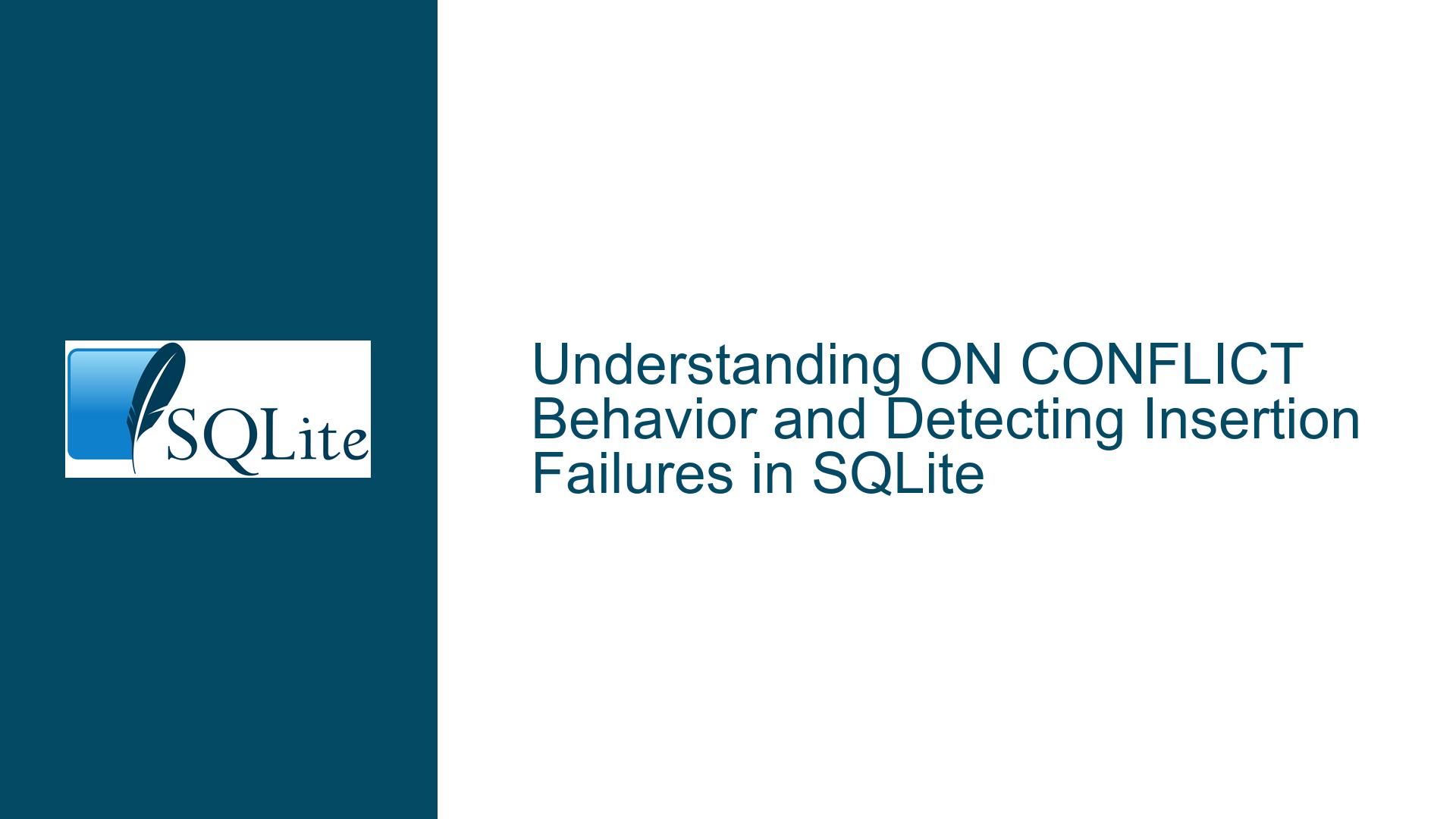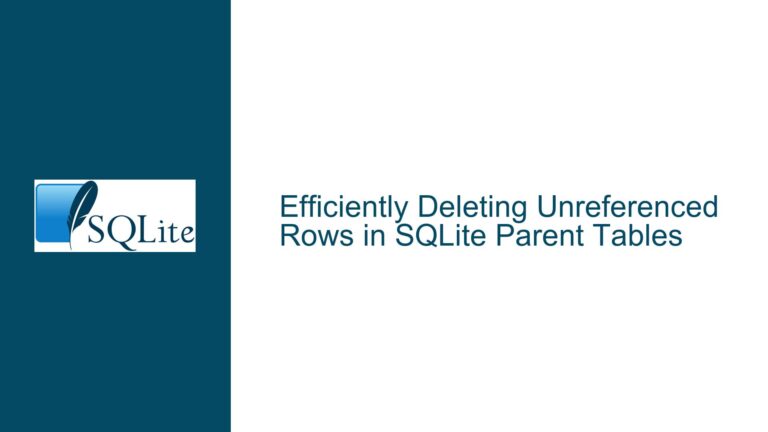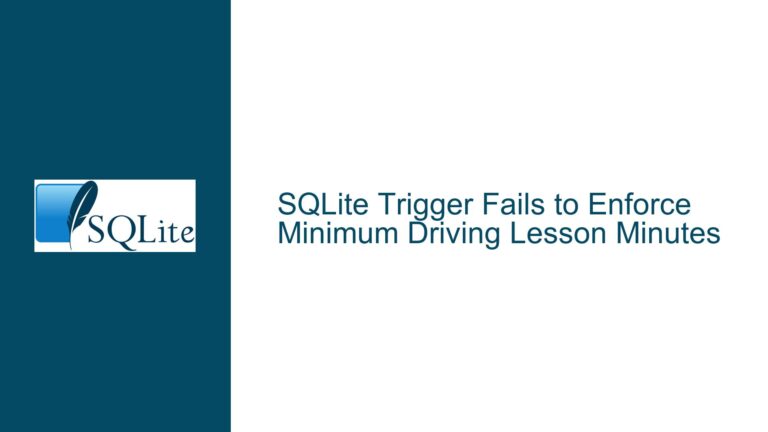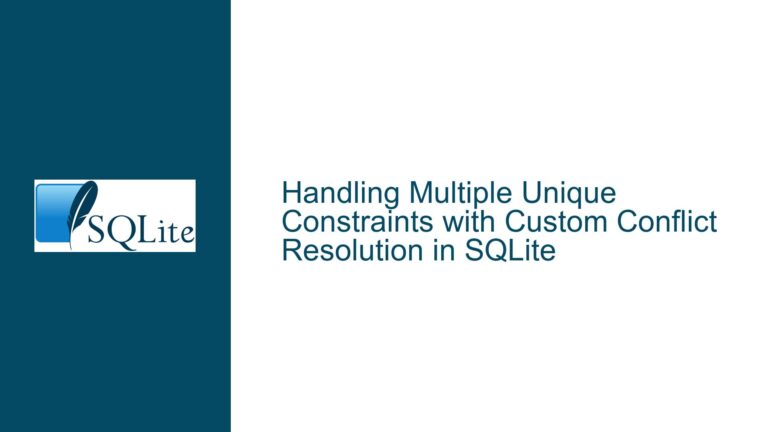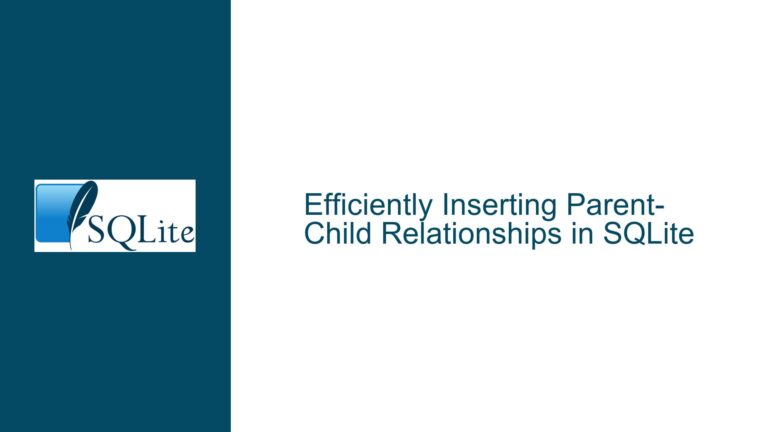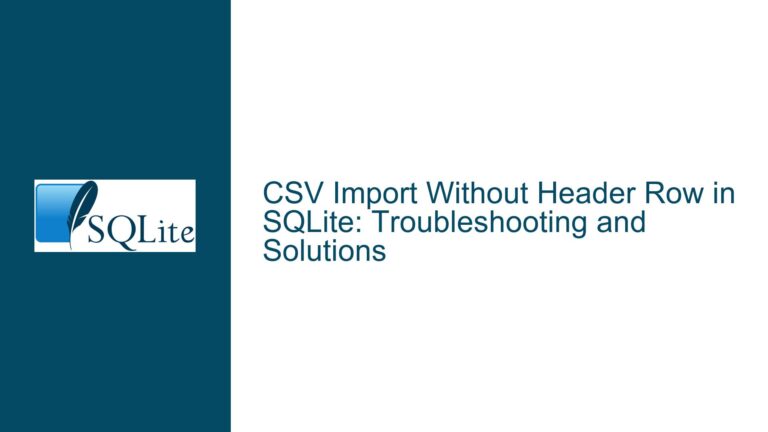ON CONFLICT Behavior and Detecting Insertion Failures in SQLite
Issue Overview: ON CONFLICT DO NOTHING and Silent Insertion Failures
When working with SQLite, the ON CONFLICT clause is a powerful tool for handling constraint violations during INSERT operations. However, its behavior can sometimes be counterintuitive, especially when using the DO NOTHING action. The core issue here revolves around determining whether a new row was successfully inserted or if the insertion was silently ignored due to a conflict, particularly when a UNIQUE constraint is violated.
In the provided scenario, the table wwFlights has a UNIQUE index on the sessionId column. The INSERT statement uses ON CONFLICT(sessionId) DO NOTHING, which means that if a row with the same sessionId already exists, the insertion will be silently ignored without raising an error. The problem arises because the $success variable, which is intended to indicate the success of the insertion, always returns true, even when no row is inserted due to a conflict. This behavior makes it difficult to distinguish between a successful insertion and a silent conflict resolution.
The challenge is to find a reliable way to detect whether a new row was added or if the insertion was ignored due to a conflict. This is particularly important in scenarios where the application logic depends on knowing whether the insertion was successful or not. For example, if the application needs to log or handle conflicts differently, it must be able to detect when a conflict occurs.
Possible Causes: Why ON CONFLICT DO NOTHING Always Returns True
The ON CONFLICT DO NOTHING clause in SQLite is designed to handle constraint violations by silently ignoring the insertion attempt. This behavior is intentional and is useful in scenarios where conflicts are expected and do not require any special handling. However, this design choice also means that the INSERT statement will not raise an error or return a failure status when a conflict occurs. Instead, it will simply do nothing and return successfully, which is why $success always returns true.
One possible cause of this behavior is the way SQLite handles the ON CONFLICT clause internally. When a conflict is detected, SQLite does not consider it an error condition because the DO NOTHING action explicitly instructs it to ignore the conflict. As a result, the INSERT statement completes successfully, and the application is not notified of the conflict.
Another factor to consider is the use of the UNIQUE constraint on the sessionId column. The UNIQUE constraint ensures that no two rows in the wwFlights table can have the same sessionId. When an insertion attempt is made with a sessionId that already exists, the UNIQUE constraint is violated, and the ON CONFLICT DO NOTHING clause is triggered. However, since the DO NOTHING action is used, the conflict is silently ignored, and the insertion is not performed.
Additionally, the absence of a PRIMARY KEY on the wwFlights table might contribute to the confusion. While a PRIMARY KEY is not strictly necessary for the UNIQUE constraint to work, it can provide additional clarity and structure to the table schema. However, in this case, the lack of a PRIMARY KEY does not directly cause the issue with ON CONFLICT DO NOTHING always returning true.
Troubleshooting Steps, Solutions & Fixes: Detecting Insertion Failures and Handling Conflicts
To address the issue of detecting whether a new row was added or if the insertion was ignored due to a conflict, several approaches can be considered. Each approach has its own advantages and trade-offs, and the choice of solution will depend on the specific requirements of the application.
1. Using RETURNING Clause to Detect Successful Insertions
One effective way to determine whether a new row was inserted is to use the RETURNING clause in the INSERT statement. The RETURNING clause allows you to retrieve the values of the inserted row, which can be used to confirm whether the insertion was successful.
For example, you can modify the INSERT statement to return the sessionId of the inserted row:
$result = sqInsert(
"wwflights",
"INSERT INTO wwFlights (sessionId, aircraftIcao, simId, textureId, fpdate, mtlId)
VALUES (:sessionId, :aircraftIcao, :simId, :textureId, :fpdate, :mtlId)
ON CONFLICT(sessionId) DO NOTHING
RETURNING sessionId",
[
"sessionId" => $sessionId,
"aircraftIcao" => $aircraftIcao,
"simId" => $simId,
"textureId" => $textureId,
"fpdate" => $fpdate,
"mtlId" => $mtlId,
]
);
if ($result) {
// A new row was inserted
} else {
// No row was inserted due to a conflict
}
In this example, the RETURNING sessionId clause ensures that the sessionId of the inserted row is returned if the insertion is successful. If no row is inserted due to a conflict, the RETURNING clause will return NULL, allowing you to detect the conflict.
2. Using sqlite3_changes() to Check for Insertions
Another approach is to use the sqlite3_changes() function, which returns the number of rows modified, inserted, or deleted by the most recently completed INSERT, UPDATE, or DELETE statement. This function can be used to determine whether a row was inserted or if the insertion was ignored due to a conflict.
For example, you can execute the INSERT statement and then check the value returned by sqlite3_changes():
$success = sqInsert(
"wwflights",
"INSERT INTO wwFlights (sessionId, aircraftIcao, simId, textureId, fpdate, mtlId)
VALUES (:sessionId, :aircraftIcao, :simId, :textureId, :fpdate, :mtlId)
ON CONFLICT(sessionId) DO NOTHING",
[
"sessionId" => $sessionId,
"aircraftIcao" => $aircraftIcao,
"simId" => $simId,
"textureId" => $textureId,
"fpdate" => $fpdate,
"mtlId" => $mtlId,
]
);
$changes = sqlite3_changes($db);
if ($changes > 0) {
// A new row was inserted
} else {
// No row was inserted due to a conflict
}
In this example, the sqlite3_changes() function is used to check the number of rows affected by the INSERT statement. If the number of changes is greater than 0, it means a new row was inserted. If the number of changes is 0, it means no row was inserted due to a conflict.
3. Using ON CONFLICT FAIL or ON CONFLICT ABORT to Raise Errors
If you need to be notified of conflicts and handle them explicitly, you can use the ON CONFLICT FAIL or ON CONFLICT ABORT actions instead of ON CONFLICT DO NOTHING. These actions will cause the INSERT statement to raise an error when a conflict occurs, allowing you to detect and handle the conflict in your application code.
For example, you can modify the INSERT statement to use ON CONFLICT FAIL:
try {
$success = sqInsert(
"wwflights",
"INSERT INTO wwFlights (sessionId, aircraftIcao, simId, textureId, fpdate, mtlId)
VALUES (:sessionId, :aircraftIcao, :simId, :textureId, :fpdate, :mtlId)
ON CONFLICT(sessionId) FAIL",
[
"sessionId" => $sessionId,
"aircraftIcao" => $aircraftIcao,
"simId" => $simId,
"textureId" => $textureId,
"fpdate" => $fpdate,
"mtlId" => $mtlId,
]
);
// If no exception is thrown, the insertion was successful
} catch (Exception $e) {
// Handle the conflict
}
In this example, the ON CONFLICT FAIL action causes the INSERT statement to raise an error when a conflict occurs. The error can be caught and handled in the application code, allowing you to take appropriate action when a conflict is detected.
4. Using ON CONFLICT ROLLBACK for Transactional Integrity
If the INSERT statement is part of a larger transaction and you need to ensure that the entire transaction is rolled back in case of a conflict, you can use the ON CONFLICT ROLLBACK action. This action will cause the entire transaction to be rolled back if a conflict occurs, ensuring that no partial changes are committed.
For example, you can modify the INSERT statement to use ON CONFLICT ROLLBACK:
try {
$success = sqInsert(
"wwflights",
"INSERT INTO wwFlights (sessionId, aircraftIcao, simId, textureId, fpdate, mtlId)
VALUES (:sessionId, :aircraftIcao, :simId, :textureId, :fpdate, :mtlId)
ON CONFLICT(sessionId) ROLLBACK",
[
"sessionId" => $sessionId,
"aircraftIcao" => $aircraftIcao,
"simId" => $simId,
"textureId" => $textureId,
"fpdate" => $fpdate,
"mtlId" => $mtlId,
]
);
// If no exception is thrown, the insertion was successful
} catch (Exception $e) {
// Handle the conflict and rollback the transaction
}
In this example, the ON CONFLICT ROLLBACK action ensures that the entire transaction is rolled back if a conflict occurs. This approach is useful in scenarios where transactional integrity is critical, and you need to ensure that no partial changes are committed in case of a conflict.
5. Using a Separate Query to Check for Existing Rows
Another approach is to perform a separate query to check if a row with the same sessionId already exists before attempting the insertion. This approach allows you to detect conflicts before they occur and handle them appropriately.
For example, you can execute a SELECT statement to check for an existing row with the same sessionId:
$existingRow = sqSelect(
"wwflights",
"SELECT sessionId FROM wwFlights WHERE sessionId = :sessionId",
[
"sessionId" => $sessionId,
]
);
if ($existingRow) {
// A row with the same sessionId already exists
} else {
// Proceed with the insertion
$success = sqInsert(
"wwflights",
"INSERT INTO wwFlights (sessionId, aircraftIcao, simId, textureId, fpdate, mtlId)
VALUES (:sessionId, :aircraftIcao, :simId, :textureId, :fpdate, :mtlId)",
[
"sessionId" => $sessionId,
"aircraftIcao" => $aircraftIcao,
"simId" => $simId,
"textureId" => $textureId,
"fpdate" => $fpdate,
"mtlId" => $mtlId,
]
);
if ($success) {
// The insertion was successful
} else {
// Handle the insertion failure
}
}
In this example, a SELECT statement is used to check if a row with the same sessionId already exists. If a row is found, the application can handle the conflict appropriately. If no row is found, the application proceeds with the insertion.
6. Using a Combination of Approaches for Robust Conflict Handling
In some cases, it may be beneficial to use a combination of the above approaches to achieve robust conflict handling. For example, you can use the RETURNING clause to detect successful insertions and the sqlite3_changes() function to confirm that a row was inserted. Additionally, you can use a separate query to check for existing rows before attempting the insertion.
For example, you can combine the RETURNING clause and sqlite3_changes() function as follows:
$result = sqInsert(
"wwflights",
"INSERT INTO wwFlights (sessionId, aircraftIcao, simId, textureId, fpdate, mtlId)
VALUES (:sessionId, :aircraftIcao, :simId, :textureId, :fpdate, :mtlId)
ON CONFLICT(sessionId) DO NOTHING
RETURNING sessionId",
[
"sessionId" => $sessionId,
"aircraftIcao" => $aircraftIcao,
"simId" => $simId,
"textureId" => $textureId,
"fpdate" => $fpdate,
"mtlId" => $mtlId,
]
);
$changes = sqlite3_changes($db);
if ($result && $changes > 0) {
// A new row was inserted
} else {
// No row was inserted due to a conflict
}
In this example, the RETURNING clause is used to retrieve the sessionId of the inserted row, and the sqlite3_changes() function is used to confirm that a row was inserted. This combination provides a robust way to detect successful insertions and handle conflicts appropriately.
Conclusion
Detecting whether a new row was inserted or if the insertion was ignored due to a conflict in SQLite can be challenging, especially when using the ON CONFLICT DO NOTHING clause. However, by using the RETURNING clause, the sqlite3_changes() function, or a combination of approaches, you can effectively detect and handle conflicts in your application. Additionally, using ON CONFLICT FAIL, ON CONFLICT ABORT, or ON CONFLICT ROLLBACK can provide more explicit control over how conflicts are handled, ensuring that your application behaves as expected in all scenarios.
